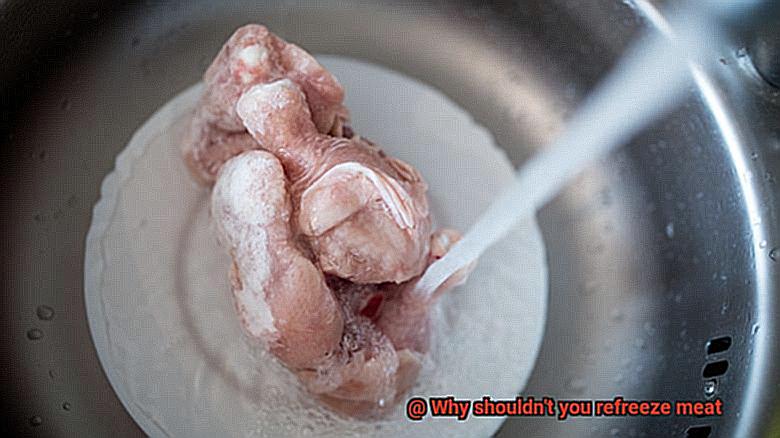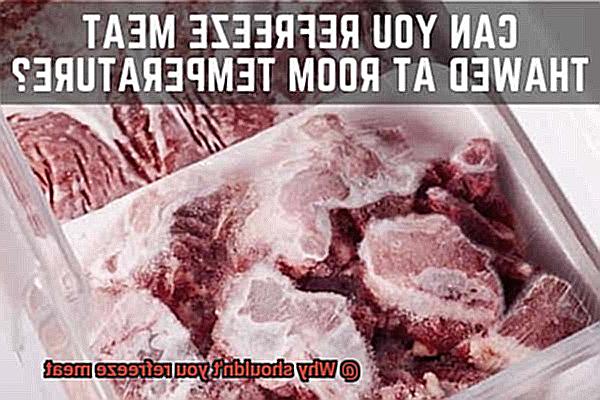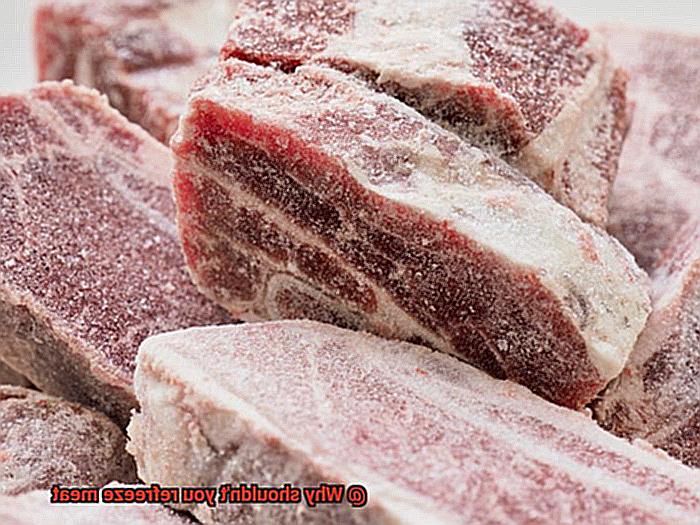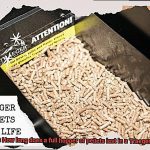Have you ever thawed frozen meat, only to realize that you don’t need it anymore? Or maybe you’ve left it out on the counter for too long and thought, “Eh, I’ll just refreeze it.” Well, hold up. Refreezing meat might seem like a convenient solution, but it can actually be dangerous to your health.
Here’s the deal: when you thaw meat, bacteria start to grow because the temperature is no longer below freezing. Refreezing the meat doesn’t kill these bacteria – it just puts them on pause until the next time you thaw it. And when that happens, those bacteria will start to multiply again, increasing your risk of getting sick.
So why take the risk? In this blog post, we’re going to dive into the science behind why refreezing meat is a bad idea. We’ll also talk about some safe alternatives for dealing with leftover or unused meat. Plus, we’ll share some tips from the FDA on how to properly handle frozen meat.
Whether you’re a carnivore or just someone who wants to avoid food poisoning (who doesn’t?), keep reading for everything you need to know about why you shouldn’t refreeze meat.
Contents
Ice Crystals Form Inside the Meat
The process of freezing meat has been a popular way to preserve and extend its shelf life for decades. However, many are unaware of the potential risks that come with this method of preservation. One of the most significant dangers is the formation of ice crystals inside the meat during freezing.
These ice crystals can cause harm to the muscle fibers and tissues in the meat, leading to a loss of flavor and texture once thawed. The damage caused by freezing can be exacerbated if the meat is refrozen. As the ice crystals expand and contract during the thawing and refreezing process, they can cause further damage to the meat’s structure, resulting in an even greater loss of flavor and texture.
Additionally, refreezing meat can lead to a higher risk of bacterial growth. Bacteria can survive in frozen meat and multiply when it is thawed. If this meat is then refrozen without being properly cooked first, the bacteria will continue to multiply, increasing the risk of foodborne illness.
To ensure both food safety and quality, it is recommended to only freeze meat once and thaw it properly before cooking. Proper thawing involves placing the frozen meat in the refrigerator until fully thawed. Refreezing should be avoided whenever possible.
It’s also important to purchase meats that have not been previously frozen and thawed multiple times before reaching the grocery store. Meats that have undergone this process are more likely to be damaged and have a higher risk of bacterial growth.
If you have leftover cooked meat that has been frozen, it is safe to refreeze as long as it was thawed properly and stored in the refrigerator within two hours of cooking. However, keep in mind that refreezing may still affect the quality of the meat.
Bacteria Can Multiply Rapidly
Bacteria can multiply rapidly, especially when meat is left at room temperature for an extended period. This can create a breeding ground for harmful bacteria that can cause foodborne illness and hospitalization in severe cases. To prevent this from happening, it’s essential to handle your meat properly.
When meat is thawed and refrozen, any bacteria that were present before freezing will continue to grow once the meat is thawed again. This means that if you don’t handle your meat properly, you could be putting yourself and your loved ones at risk.
To avoid bacterial growth on meat, here are some tips to keep in mind:
- Thaw meat in the refrigerator or in cold water, never at room temperature.
- Cook meat to the appropriate internal temperature to kill any harmful bacteria that may be present.
- Once the meat has been thawed, it should be cooked immediately or stored in the refrigerator and consumed within a few days.
It’s important to note that even if the meat is thoroughly cooked after being refrozen, toxins produced by bacteria may still be present and cause illness. So always err on the side of caution when handling meat.
The longer the meat is left at room temperature, the more time bacteria have to multiply and reach harmful levels. So to keep yourself safe from foodborne illness, it’s imperative to follow these guidelines.
Quality of the Meat Deteriorates
While freezing can be an excellent way to extend the shelf life of meat, refreezing can lead to a decline in quality that affects texture, juiciness, tenderness, and flavor.
The science behind it is fascinating. When meat is frozen, the water inside it expands and forms ice crystals that can harm the cells and fibers of the meat. Repeatedly thawing and refreezing can cause further damage as water molecules continue to expand and contract, breaking down the structure of the meat even more. The result? Meat that’s dry, tough, or even mushy.
Moreover, thawing meat at room temperature for a prolonged period can encourage bacterial growth, which multiplies when you refreeze the meat. This increases the risk of foodborne illness and affects your health.
However, there’s no need to worry. For best results, only freeze meat once and thaw it correctly before cooking. Thawing in the refrigerator or cold water are safe methods that preserve meat quality while avoiding bacterial growth.
To ensure your meat stays fresh for longer, consider dividing it into smaller portions before freezing. This way, you can avoid the need for refreezing and enjoy your favorite cuts with maximum freshness.
Raw vs Cooked Meat Refreezing Debate

The debate is ongoing, and for good reason – the answer depends on a number of factors that can affect both safety and quality.
Let’s start with raw meat. When raw meat is thawed, bacteria that were present before freezing can become active and start multiplying again. Refreezing raw meat after it has been thawed can cause these bacteria to continue to multiply and potentially cause foodborne illnesses. To avoid this risk, it’s important to ensure that your raw meat is thawed in a safe manner – either in the fridge or in the microwave. Any other method, such as thawing at room temperature or in warm water, can create an ideal environment for bacteria growth.

On the other hand, cooked meat that has been properly handled and stored can be refrozen safely. Cooking meat kills most bacteria, so if the meat was cooked thoroughly before being frozen and has been stored at a safe temperature, it can be refrozen without significant risk of foodborne illness. However, it’s important to keep in mind that each time meat is thawed and refrozen, its quality can deteriorate. The texture and flavor of the meat can be damaged during the freezing and thawing process, resulting in a less enjoyable eating experience.
To further break down the topic of refreezing meat, here are some sub-topics to consider:
- Thawing methods: How was the meat thawed before being refrozen?
- Cooking: Was the meat cooked before being frozen?
- Storage: Was the meat stored properly before and after thawing?
- Refreezing frequency: How many times has the meat been thawed and refrozen?
Plan Ahead and Only Thaw What You Need
This practice can be unsafe and unappetizing. But don’t worry, with a little planning, you can avoid these problems and enjoy your meat to the fullest.
Let’s start with the science behind it. Freezing meat creates ice crystals that damage the cell walls of the meat. When thawed, the moisture loss caused by these damaged cells results in tougher and less flavorful meat. Not exactly what you’re craving, right?
But here’s where it gets dangerous. Thawing meat allows bacteria to grow in the temperature danger zone of 40°F – 140°F. Refreezing the meat won’t eliminate these bacteria but instead, provides them with a breeding ground to continue growing and multiplying. Consuming refrozen meat can lead to food poisoning, which is not worth the risk.
So, what’s the solution? Planning ahead and only thawing what you need is key. It’s better to thaw a little more than too much if you’re unsure how much meat you’ll need for a meal. And if you end up with leftover thawed meat, cook it immediately rather than refreezing it.
To summarize, to ensure safe and delicious meat consumption, plan ahead and only thaw what you require. Avoid refreezing as it can alter the taste and texture of your meat while also posing health risks due to bacterial growth.
To make things easier, here are some practical tips:
- Plan your meals in advance and thaw only the amount of meat needed for each recipe.
- Consider using smaller portions when freezing your meats to avoid thawing more than necessary.
- If you have leftover thawed meat, cook it right away or use it in another recipe that calls for cooked meat.
Freezing Leftover Cooked Meat for Later Use
Freezing it for later use is a great solution, but there are important factors to consider. As an expert in freezing leftover cooked meat, I am here to share some helpful tips and information.
Firstly, it is crucial to avoid refreezing meat as it can be unsafe due to the risk of bacterial growth and contamination. When meat is initially frozen, ice crystals form within it, which can cause damage to its cellular structure, resulting in a dry and tough texture when defrosted. Refreezing the meat can further harm its quality and make it less appetizing when consumed.
Moreover, bacteria can grow and multiply rapidly when meat is left at room temperature for too long. Freezing the meat may temporarily halt this process, but refreezing and thawing again can contribute to the growth of harmful bacteria if present.
To mitigate these risks, it is best to only freeze leftover cooked meat once and use it within a reasonable amount of time. Proper storage in an airtight container labeled with the date of freezing is essential. When thawing the meat, use a refrigerator or microwave and avoid leaving it out at room temperature.
Food Safety Practices to Avoid Getting Sick
One crucial practice is avoiding the temptation to refreeze meat. When you freeze meat, ice crystals form within it. Upon thawing the meat, this creates moisture which can become a breeding ground for harmful bacteria. Foodborne illnesses like salmonella, E. coli, and listeria can be caused by bacteria growth in refrozen meat. These illnesses can range from mild to severe and even be fatal in some cases.
To prevent such illnesses, we should handle food properly and follow food safety guidelines. The USDA recommends cooking thawed meat immediately or storing it in the refrigerator for a few days before consuming. If you need to refreeze cooked meat, make sure it has been cooled down first.
However, refreezing meat isn’t the only thing to be mindful of when it comes to food safety practices. Not all foods are suitable for freezing. Foods like lettuce, cucumbers, and tomatoes lose their texture when frozen and thawed. Eggs in their shells and canned goods should never be frozen because they can expand and crack or even explode in the freezer.
By following these food safety practices, we can prevent foodborne illnesses caused by harmful bacteria like salmonella, E. coli, and listeria. These illnesses can be severe and even fatal in some cases, so it’s crucial that we take food safety seriously.
In summary, to avoid getting sick from your food, follow these food safety practices:
- Avoid refreezing meat
- Cook thawed meat immediately or store it properly
- Be mindful of which foods are suitable for freezing
Common Mistakes When Refreezing Meat
We all want to save time and money by reusing leftovers or freezing meat we can’t consume right away, but it’s crucial to be aware of the risks of foodborne illnesses caused by harmful bacteria.
The first mistake people make is refreezing meat without realizing the danger. Freezing meat causes water expansion, which can damage the cell walls, leading to a loss of flavor and nutrients. Refreezing exacerbates this problem, making the meat more susceptible to bacterial growth.
Another common mistake is improper thawing before refreezing. Bacteria thrive in warm temperatures, so if meat is not thawed correctly, it can lead to bacterial growth and ultimately food poisoning. Always thaw meat in the fridge or cold water instead of leaving it at room temperature.
Leaving meat out for too long is another mistake that can cause bacterial growth. If your meat has been outside the fridge for more than two hours, throw it away immediately instead of risking contamination. If it’s been less than two hours, it’s safe to refreeze after proper thawing.
Lastly, people often make the mistake of refreezing cooked meat. Unfortunately, freezing and thawing can affect the flavor and texture of cooked meat, making it less appetizing than when fresh. It’s best to consume cooked meat as soon as possible instead of freezing it again.
h4aSaDclwb4″ >
Conclusion
In summary, refreezing meat may seem like a quick fix, but it poses serious health risks. When you thaw meat, bacteria begin to multiply due to the temperature change. Refreezing the meat doesn’t kill these bacteria; it simply puts them on hold until the next thawing session. This increases your chances of getting sick and can lead to foodborne illnesses caused by harmful bacteria.
Furthermore, freezing causes ice crystals to form inside the meat, which can damage its texture and flavor when thawed. Refreezing exacerbates this problem as the ice crystals expand and contract during thawing and refreezing. This leads to further damage to the meat’s structure.
To ensure food safety and quality, it’s best to freeze meat only once and thaw it properly before cooking. Proper thawing involves placing frozen meat in the refrigerator until fully defrosted. Avoid refreezing whenever possible.
It’s also crucial to purchase meats that haven’t been previously frozen or thawed multiple times before reaching grocery stores. Such meats are more likely to be damaged and have a higher risk of bacterial growth.






